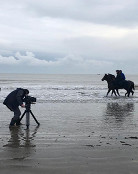Donn's Articles » Cheltenham choices
Cheltenham choices
Sir Des Champs battled on well to win the Grade 2 two-and-a-half-mile novices’ chase at Leopardstown on Saturday.
“He’s a course winner so we won’t be leaving him at home,” said winning trainer Willie Mullins afterwards when asked about Cheltenham. (They’re always asked about Cheltenham these days.) “The Jewson, perhaps,” he said, “or maybe the RSA Chase.”
When Boston Bob won the Grade 2 novices’ hurdle on Sunday, Ladbrokes said 4/1 for the Neptune Hurdle, Mullins said maybe the Albert Bartlett. He could have said the same thing about third-placed Make Your Mark, but he didn’t. He just said we’ll find something easier for him now.
Decisions, decisions. Options are good, but too many moving parts fosters instability. Mullins is not alone in facing into a six-week period of head-scratching to go with the six more weeks of eggshell-treading.
Grands Crus will go in either the Gold Cup or the RSA Chase, Oscar Whisky goes in the World Hurdle or the Champion Hurdle (60-40), Fingal Bay goes in the Albert Bartlett or the Neptune, Voler La Vedette goes in the Mares’ Hurdle or the World Hurdle, Captain Chris goes in the Gold Cup or the Ryanair Chase or doesn’t go at all, Somersby goes in the Ryanair, but he might go in the Queen Mother.
The availability of options at the Cheltenham Festival is not a new phenomenon. The majority of Supreme Novices’ Hurdle horses have also had the Neptune Hurdle option (and vice versa) since the inauguration of the latter contest in 1971, in the same way as the Grand Annual horse who stayed two miles well could always run in the Byrne Group Plate instead.
Also, the idea of novices running in the championship races is not a new one – Captain Christy was a novice when he won the Gold Cup, Make A Stand was a novice when he won the Champion Hurdle – nor is the idea of juvenile hurdlers running in the Supreme Novices’ Hurdle instead of in the Triumph, a la Hors La Loi.
However, the phenomenon seems to have exploded in recent years. The number of high-profile horses with Cheltenham Festival targets unconfirmed just a couple of weeks out seems to be perennially on the increase.
There seems to have been a change in attitude among trainers, more forward-thinking, a more open-minded outlook on the Festival. It used to be the case that, generally, if you had a top class two-mile novice chaser, you ran him in the Arkle, or if you had a top class staying novice chaser, you ran him in the RSA Chase. This year, Paul Nicholls entered Al Ferof in the Champion Chase as well as the Arkle, while Nicky Henderson entered Bobs Worth in the World Hurdle and David Pipe entered Grands Crus in the Gold Cup, despite the fact that the RSA Chase is the most logical race for both.
There are also decisions that will be influenced or determined by other decisions. Like, if Grands Crus runs in the Gold Cup instead of in the RSA Chase, does that mean that a horse like Champion Court will run in the RSA instead of in the Jewson? If Mouse Morris runs First Lieutenant and Philip Fenton runs Last Instalment in the RSA Chase, does that mean that Willie Mullins will have to run another Gigginstown House horse Sir Des Champs in the Jewson? And where would Bog Warrior run then?
Of course, the primary reason for the recent uncertainly concerning targets is the increase in the number of races run at the Festival, the proliferation of options with most horse-preferences catered for specifically (with the notable exception of the horse who wants to go right-handed on a flat track on soft ground). It is difficult for trainers, trying to pin down races, it is difficult for jockeys, trying to pin down rides, and it is difficult for punters, trying to pin down runners not to mind winners. That is not a good thing for a Festival that thrives on the build-up.
For years, there were 18 races at the Cheltenham Festival – three days, six races each day – until 1992, when first the bumper and then the Coral Cup saw the total number rise to 20. There are now 27. That’s an increase of 50% in 20 years, and of 35% in seven.
In one sense it is progress, it proves that racing has the ability to capitalise on a huge success story, and it means that more owners and trainers and riders have the opportunity to experience what it is to have a Cheltenham Festival winner. In another, however, there is a need to be wary of spreading the jam too thinly. A Cheltenham Festival winner is so special because it is so rare. With every added race you dilute it, every extra drop reduces its potency just a little.
Some of the new races, like the Ryanair Chase, work well. Some of the others, not so well. Time now to leave it alone, consolidate, allow the 27 races settle. There are enough races now, too many if anything. Savour the Cheltenham Festival as it stands, leave the eco-system as it is. It is too precious to risk changing again any time soon.
© The Racing Post, 31st January 2012


 Follow Donn
Follow Donn